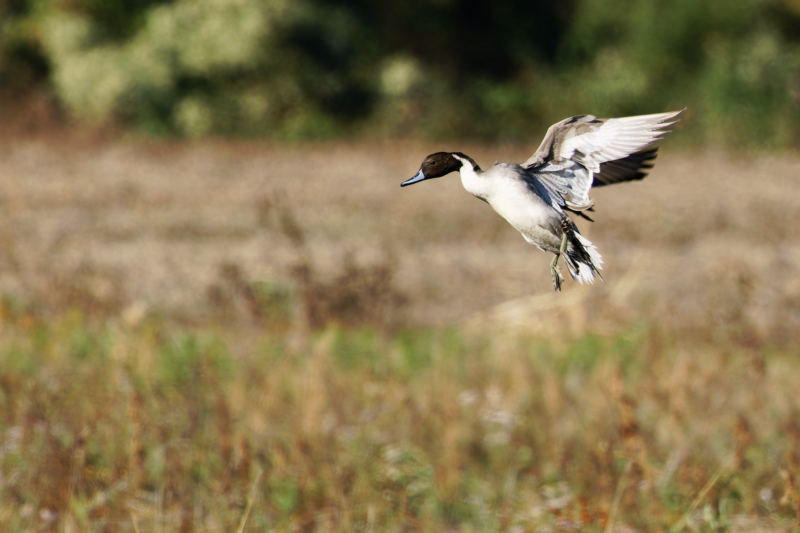I was recently at the Sequoyah National Wildlife Refuge in Oklahoma, parked along the auto tour road with my camera ready. Throughout the morning, I was treated to sightings of Greater Yellowlegs, Northern Shovelers, and even a few Wilson’s Snipes working the shallow water in a flooded field nearby.
As the morning progressed, I noticed a group of ducks landing in the water. From a distance, I could tell a few were Northern Shovelers, their distinctive spatulate bills gave them away immediately. But there was one duck that caught my eye as he was coming in for a landing. I just could not identify him. His slender black bill and gray, elongated body were unlike the other puddle ducks I was used to seeing. I quickly grabbed my camera and was fortunately able to capture a couple photographs of this mystery duck as he gracefully descended onto the water.

When I returned home, I sent the images to my friend and fellow wildlife photographer Mia McPherson to get her expert opinion. She wrote back informing me that I had photographed a Northern Pintail drake! The elegant tapered silhouette and delicate long tail feathers give the species its name. The drake’s chocolate-brown head, white breast, and those elongated central tail feathers make them one of the most distinctive and elegant ducks in North America. Getting to see this striking bird visiting from its breeding grounds up north made waking up before sunrise completely worth it!
Wildlife Notes
Northern Pintails are fascinating migrants that breed primarily in Alaska and Canada’s prairie pothole region. They then travel thousands of miles south for winter. Sequoyah National Wildlife Refuge sits along the Central Flyway, one of the major migration routes in North America. This makes it an important resting and feeding area for pintails and thousands of other waterfowl. The refuge hosts diverse waterfowl populations including mallards, wigeons, wood ducks, and various other species. It’s also known for hosting the largest flocks of snow geese in Oklahoma.
I feel so fortunate to have encountered and captured images of such a beautiful duck on his migratory travels. Part of me hopes he enjoyed his stay at the refuge so much that he returns next year. I know I definitely plan to as well, eager to see what other feathered surprises await!
Photography Notes
This shot presented some interesting technical challenges. The Northern Pintail drake was captured mid-descent with wings fully extended. This required a fast shutter speed to freeze the motion. I was shooting with my Canon EOS R7 paired with the RF 100-500mm lens at the full 500mm focal length. This gave me the reach I needed from my position along the auto tour road.
The lighting conditions that morning required pushing the ISO to 3200. That’s getting up there but still manageable with the R7’s crop sensor. The aperture was at f/7.1, which was wide open for the lens at 500mm. Not ideal for depth of field, but necessary to maintain that 1/1000 second shutter speed in the available light. I also dialed in -0.3 exposure compensation to prevent the white breast of the pintail from blowing out against the darker background.
The key to this image was anticipation and being ready. When you’re photographing waterfowl, especially during migration season, you never know what’s going to drop in. Having the camera up and settings dialed in for birds in flight gave me the split second I needed. I captured this drake before he hit the water. The R7’s autofocus tracking did excellent work keeping the bird sharp as he descended.
One thing I’d note: at ISO 3200, there will be some noise in the image, especially in the shadow areas. But when you’re faced with the choice between a noisy sharp image and a clean blurry one, take the noise every time. You can reduce noise in post-processing, but you can’t fix motion blur.
Camera Settings:
- Camera: Canon EOS R7
- Lens: RF 100-500mm F4.5-7.1 L IS USM
- ISO: 3200
- Aperture: f/7.1
- Shutter Speed: 1/1000 sec
- Exposure Compensation: -0.3
- Focal Length: 500mm
